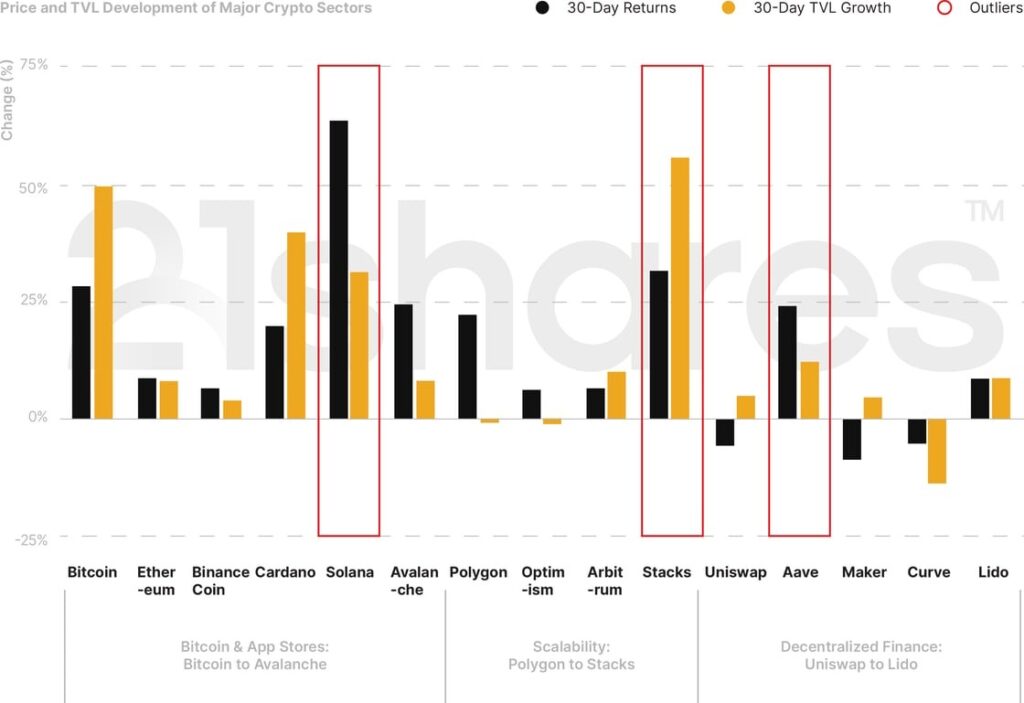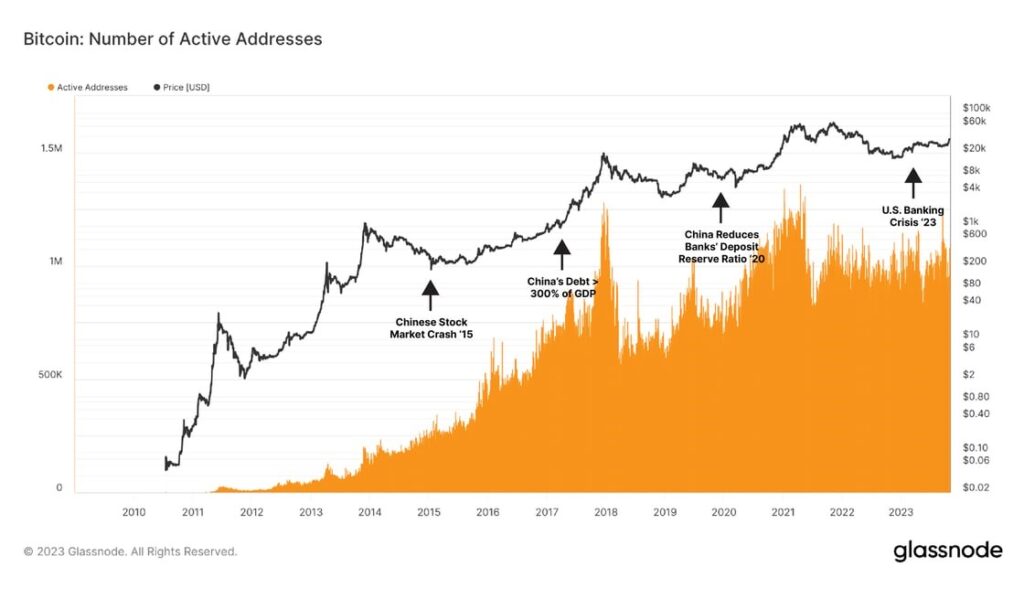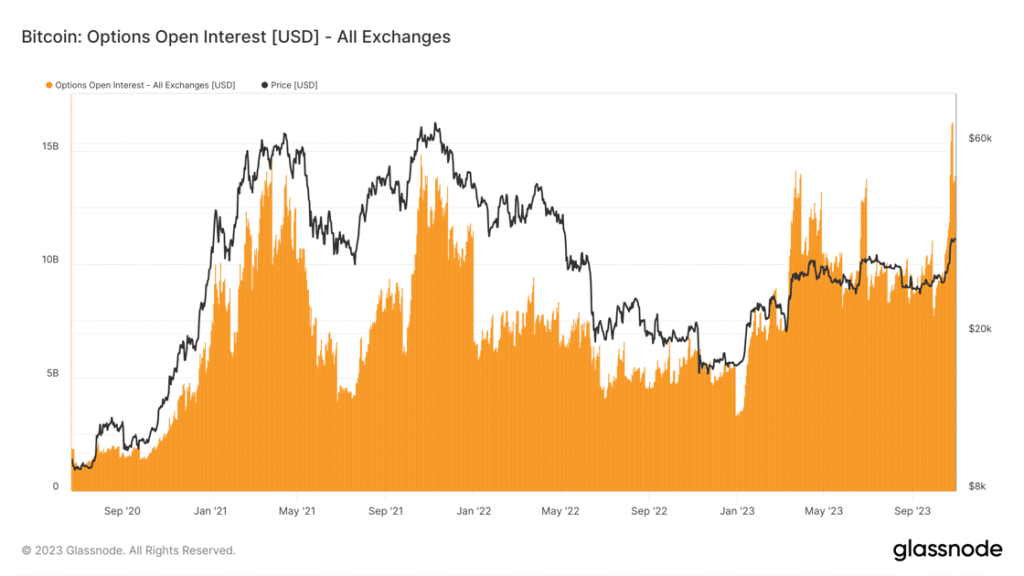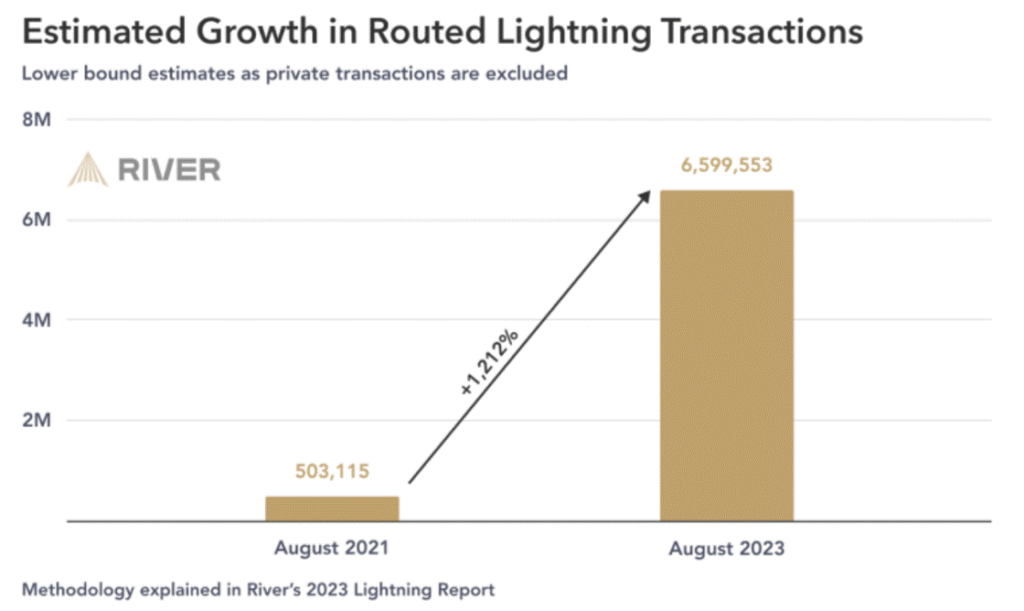Performance Drivers and Underlying Developments: What Happened in Crypto in October?
October was a turbulent month in macroeconomics, bringing tailwinds to crypto. Bitcoin has decoupled from the S&P500 amidst the turbulent macro environment, recording a 0.3 correlation this month. Historically, Bitcoin has been considered a risk-on asset, but recent price action suggests that investors may turn to Bitcoin as a flight to quality. Bitcoin and Ethereum increased by 27.92% and 8.30% over the past month, respectively. The biggest winner of this month was Solana, soaring by 63.44% on the back of a recent upgrade on its network that would make it a more favorable option for developers; we delve deeper into what this upgrade means later in this report. Bitcoin’s scalability solution, Stacks, also increased by 31.44% in price and 55.49% in assets under management after speeding up the transaction process. Within decentralized finance applications, Aave was the biggest winner, increasing by 23.99%.
Figure 1: Price and TVL Development of Major Crypto Sectors in October 2023

Source: 21shares, CoinGecko, DeFi Llama. Data as of October 30, 2023.
5 Trends to Remember from October
Macro Factors Contributing to Bitcoin’s Performance
China’s $14 trillion debt crisis, instigated by Chinese real estate giants a few months ago, seems to have contributed to Bitcoin’s performance over the past month. Historically, financial crises in China are inversely correlated with Bitcoin’s price and active addresses, as shown in the figure below. At the brink of the pandemic in January 2020, the People’s Bank of China injected $115B into the economy by reducing the deposit reserve ratio in financial institutions by 0.5 percentage points. A week after the announcement, Bitcoin’s price jumped by 13%, and active BTC addresses increased by 48%, according to data provider Glassnode.
Figure 2: Bitcoin’s Performance Amid Financial Crises

Source: 21shares, Glassnode
Another contributor to the flight to Bitcoin could be the U.S. public debt-to-GDP ratio, estimated to have reached 97.6% in October. In 2022, the Federal Reserve added $267.1B to its money supply, and it will need to print more in the long term to service its 33 trillion-dollar debt, up from $30.93 trillion last year. Bitcoin’s narrative as a hedge against monetary debasement shines brighter amid this macroeconomic environment. Moreover, Bank of America’s unrealized losses on securities rose to $131.6B after the 10-year U.S. Treasury yield reached 4.93%, a figure not seen since 2007, before the Global Financial Crisis. Many investors consider U.S. Treasuries the best proxy of a “risk-free” rate and thus view them as an opportunity cost – lower expected yields lead to lower discount rates, which result in a higher value for risky assets like stocks and crypto.
Bitcoin Derivatives on the Rise
The surge in Bitcoin’s performance amid the turbulent macroeconomic environment invited new market participation in the crypto derivatives market. Bitcoin options open interest on all exchanges reached an all-time high towards the end of October, as shown in the figure below, reaching over the $16B mark, which could signal impending volatility to either side. The Chicago Mercantile Exchange (CME) is on the brink of toppling Binance, the world’s largest crypto derivatives market by trading volume so far, making up close to 25% of BTC futures open interest market. In October, CME accrued $3.54B in notional open interest in Bitcoin, only 8% less than Binance’s. On Deribit Exchange, the largest crypto options exchange, combined notional open interest in Bitcoin and Ethereum options has surged to $20.5B, paralleling the late 2021 bull market peak, which signals that the risk appetite is picking up among investors.
Figure 3: Bitcoin Options Open Interest

Source: Glassnode
CBDCs Coming More into the Spotlight
Central bank digital currencies (CBDCs) have emerged this month across many jurisdictions. For the first time, the world’s first CBDC, the digital yuan, was used to settle a cross-border deal of 1 billion barrels of crude oil on the Shanghai Petroleum and Natural Gas Exchange (SHPGX) on October 19—a significant milestone for e-CNY, which has seen a 35% yearly increase in cross-border settlements. Moreover, Ethereum also rose as an infrastructure layer for Mastercard’s initiative to tokenize the eAUD, implementing the KYC verification through the fintech giant’s digital identity solution to govern the CBDC’s transactions. On October 18, the European Central Bank (ECB) announced the beginning of the preparation phase of its digital euro. The ECB has been exploring the design and distribution parameters of its CBDC since October 2021. Established payment providers such as Mastercard are actively working on initiatives to foster collaboration between CBDCs and stablecoins. A recent example is their pilot program, which aims to establish interoperability between CBDCs and stablecoins, ensuring compatibility with DeFi platforms, which should reduce the gap and introduce further synergy.
Extrapolating Blockchain’s Value Proposition Beyond Traditional Finance
Vodafone completed a proof of concept that enhances the outdated global trade ecosystem. The initiative, done in collaboration with Sumitomo Corporation, Chainlink Labs, and InnoWave, introduces a system for seamlessly exchanging digitized trading documents dispersed across multiple blockchains and platforms to overcome the fragmentation present in traditional systems. By leveraging Chainlink’s CCIP, the initiative demonstrated how trading firms could avoid unnecessary cargo movement delays by streamlining the exchange of shipping receipts in a standardized way across multiple parties while offering an automated mechanism for executing certain trading agreements, such as triggering cargo insurance if a ship detects fire across its inventories. This is a noteworthy development as switching from the current system of transferring physical paper bills could save $6.5B in direct costs. However, there needs to be a mechanism for interconnecting the plethora of platforms involved in the digitization process, which is why this could be a key business opportunity for Chainlink to expand its interoperability services beyond financial applications and target the 32T global industry.
Solana to Become More Decentralized while Enabling Confidential Transactions
Solana’s latest software upgrade (v1.16) introduced several notable enhancements. The improvements include reducing validator hardware requirements by reducing RAM usage from 120 GB to 39 GB and fine-tuning for bandwidth constraints. However, the standout feature is the ability to encrypt transactional details, such as the number of transferred tokens and the total balance of both counterparties, while preserving auditing rights to ensure compliance via Zero Knowledge Proofs (ZKP) decryption mechanism. ZKP refers to a method where one party can prove possession of certain information without revealing the underlying content.
This is vital as it enables users to transact confidentially, a key factor for institutional adoption. In addition, the reduced hardware requirements make it easier to be supported by a broader range of validators, thus making it less prone to centralization. Solana’s recent surge in inflows, reaching levels not seen since 2022 ($24M), coupled with a consistent rise in daily active users for five consecutive weeks, as seen in Figure 4, underscores the enthusiasm for this overlooked upgrade. It is worth noting that FTX-related wallets were spotted sending ~$35M worth of SOL to a few exchanges, as well as unstaking $50M worth of the token. This might exert some selling pressure in the coming weeks, so we’ll be closely monitoring.
Figure 4: Solana Daily Active Addresses

Source: TheBlock
What to Expect
Bitcoin Becoming a Tech Play and Growing Beyond a Hedge Against Monetary Debasement and Counterparty Failure
In October, Bitcoin saw significant developments aiming to expand its capabilities. BitVM, a new Virtual Machine, was introduced to enable more complex computations, similar to Ethereum’s smart contracts. The key distinction lies in BitVM’s off-chain execution of applications, which are then verified on-chain, akin to rollups like Arbitrum and Optimism. Thus, this approach avoids Bitcoin’s high blockspace costs while introducing more sophisticated applications without implementing breaking changes to Bitcoin’s codebase. Still, challenges like managing the vast amounts of data generated off-chain and the considerable communication overhead must be addressed for this innovation to become practical.
In a similar context, Stacks, the Bitcoin scaling layer, introduced the sBTC testnet. sBTC is a synthetic asset pegged 1-to-1 to BTC, allowing for smart contracts on Stacks and non-custodial redemption to BTC. This innovation is vital because it enables Bitcoin programmability and offers scalability for developments like Ordinals and BRC20 without altering Bitcoin’s codebase, aligning with BitVM’s goals. Both of these innovations are pivotal in transforming the use of Bitcoin and expanding its utility to a broader user base.
On another note, Lightning Labs launched Taproot Asset Daemon’s mainnet alpha, harnessing the 2021 Taproot upgrade to enable Bitcoin-based asset issuance and management on the Lightning Network. This innovation transforms Bitcoin into a versatile, multi-asset payment network, facilitating transactions with various currencies, including stablecoins and real-world assets. Notably, despite challenging market conditions and diminishing interest in Bitcoin over the past two years, the growing adoption of the Lightning Network is striking, as seen below, with a substantial 25% of its activity focused on microtransactions for gaming and streaming. This underscores Bitcoin’s potential as both a medium of exchange and a store of value when combined with innovations like the LN. However, addressing critical issues such as the recent Replacement Cycling Attack is essential for widespread Lightning Network adoption. Finally, It’s worth mentioning that web interest in Bitcoin has surged to levels last observed during the banking crisis in March, reflecting the improving sentiment surrounding the asset.
Figure 5: The Growth of Bitcoin’s Lightning Network Utilization

Source: River Financial Services
Cosmos Emerging as Infrastructure of Choice for Applications Seeking Unrestricted Customizability
Although Optimism, Arbitrum, and others pushed frameworks to help transform applications into standalone networks, the level of customizability is still limited by the design restrictions of Ethereum’s operating system (EVM). As a result, Cosmos is emerging as the go-to platform for applications seeking greater customizability with its flexible app-chain model.
Consider Celestia, a modular data availability network that chose Cosmos for its native interoperability (IBC) and modular architecture. Celestia innovatively separates key blockchain functions like execution, settlement, consensus, and data availability (DA), addressing the high costs of Ethereum data storage by isolating DA from consensus. Recently, Celestia launched Blobstreams on its mainnet, a solution tailored for L2 networks, with commitments from Arbitrum and Manta Network to adopt the solution. This integration aims to reduce data submission fees on the Ethereum mainnet, particularly benefiting Arbitrum, which currently faces the highest fee burden among scaling networks for submitting data on Ethereum.
Another is DyDx, the largest crypto perpetual protocol by volume. Initially part of the Ethereum ecosystem, the project has now transitioned to its own application-specific blockchain on Cosmos. With this shift, DyDx achieved a fully decentralized order book, offering a trading performance similar to centralized exchanges. Additionally, DyDx has established its validator set, ensuring resilience against single points of failure—a notable difference from many L2 solutions relying on a limited number of sequencers. Remarkably, DyDx V4 enables users to pay trading fees with USDC, removing a hurdle for non-native crypto users and allowing seamless access to applications without needing a native token.
That said, EVM has several enhancements in the pipeline, including the Dencun upgrade to boost L2 throughput, account abstraction for a user-friendly experience with stablecoin payments, and shared sequencing networks to enhance L2 censorship resistance. While these improvements are promising, Cosmos’s current modular architecture remains ideal for projects wanting complete control over their application design. It’s worth mentioning that Cosmos has witnessed a sustained increase in active users in recent weeks, indicating growing network adoption.
Figure 6: Daily Active Users of Several Leading Networks

Source: Artemis
Bookmarks
• Insights from our previous newsletter were featured on Coindesk.
• Senior Research Associate Adrian Fritz was featured on Boerse Muenchen.
• Our Tokenization Report was featured on multiple media outlets, such as Laura Shin’s Unchained and Coindesk.
• Check out our webinar, where the Research Team introduced the State of Crypto, featuring a special guest.
• State of Crypto issue 10 is out: discover how crypto is already changing the world! Next Month’s Calendar
These are the top events we’re closely monitoring in November.
• Open AI conference: on November 6 could revive interest in AI-related tokens

Source: 21shares, Forex Factory, CoinMarketCap
Research Newsletter
Each week the 21Shares Research team will publish our data-driven insights into the crypto asset world through this newsletter. Please direct any comments, questions, and words of feedback to research@21shares.com
Disclaimer
The information provided does not constitute a prospectus or other offering material and does not contain or constitute an offer to sell or a solicitation of any offer to buy securities in any jurisdiction. Some of the information published herein may contain forward-looking statements. Readers are cautioned that any such forward-looking statements are not guarantees of future performance and involve risks and uncertainties and that actual results may differ materially from those in the forward-looking statements as a result of various factors. The information contained herein may not be considered as economic, legal, tax or other advice and users are cautioned to base investment decisions or other decisions solely on the content hereof.












